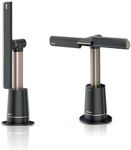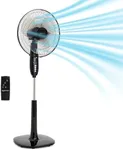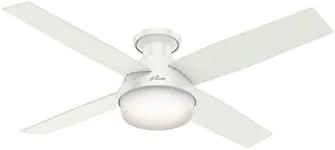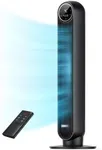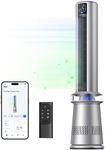Buying Guide for the Best fans
When shopping for a fan, it's important to consider where and how you'll use it, such as cooling a bedroom, circulating air in an office, or providing ventilation in a larger living space. The right fan should balance performance, noise level, size, and extra features to best suit your needs and the unique characteristics of your room. Understanding basic fan specifications can help you narrow down the large variety of options to find the perfect fit for your comfort.Fan TypeFan type refers to the basic design or style of the fan, such as pedestal, tower, desk, box, or ceiling fans. This spec is important because each type is suited to different spaces and uses: pedestal fans are larger and adjustable for floor use, tower fans are sleek and space-saving, desk fans are compact for personal use, box fans are versatile for windows or larger areas, and ceiling fans offer permanent, ceiling-mounted air circulation. If you want a fan for personal use or a small area, a desk or tower fan works best; for large rooms or whole-room air movement, consider a pedestal or ceiling fan. Your space, mobility needs, and whether the fan needs to be portable or stationary should guide this choice.
Airflow (CFM)Airflow, measured in CFM (Cubic Feet per Minute), tells you how much air the fan can move. This is essential because higher airflow means stronger cooling or ventilation. Low CFM fans (up to 1000) are good for small areas or personal cooling, medium CFM fans (1000–3000) work in bedrooms or offices, while high CFM fans (above 3000) are best for large rooms or whole-house air circulation. Match the fan's airflow to the size of your room and how much cooling you need; small spaces need less airflow, while bigger or hotter spaces need more.
Noise LevelNoise level is usually measured in decibels (dB) and describes how loud the fan will be when running. This is crucial if you're using the fan in a bedroom, office, or quiet space where excess noise could be annoying or distracting. Quiet fans typically operate at 40 dB or less, suitable for sleeping areas; medium noise (40–60 dB) might be fine for living rooms; above 60 dB can seem loud and is generally better for workshops or garages. Choose a quieter fan if you are sensitive to sound or want to use the fan while sleeping or working.
Speed SettingsSpeed settings show how many airflow power levels the fan offers, such as low, medium, and high. More speed options give you greater control over comfort and noise, letting you adjust the breeze to suit changing conditions or preferences. Simple fans have 2–3 speeds, while advanced models may have 5 or more. Go for more settings if you want precise control, otherwise basic models are fine for straightforward use.
OscillationOscillation is the fan's ability to rotate from side to side to distribute air over a wider area. This feature helps cool larger spaces evenly, rather than just one spot. If you need the fan to cool more than one person or cover a bigger part of the room, choose one that oscillates; for personal use or targeted airflow, it may not be necessary.
Size and PortabilitySize refers to the physical dimensions and weight of the fan. A compact fan can fit on a desk or nightstand, while larger fans are meant for floors or open spaces. Portability matters if you plan to move the fan between rooms. Choose a smaller or lighter fan for personal or portable needs, and a larger, more powerful model if it will mostly stay in one place to serve a bigger area.
Additional FeaturesSome fans come with extra features like remote controls, timers, air ionizers, or smart home compatibility. These can add convenience or improve air quality. If you value hassle-free use, look for remotes or programmable timers. If you want cleaner air, an ionizer might be helpful. Think about which features matter to you, but remember they are not always essential for good airflow.


